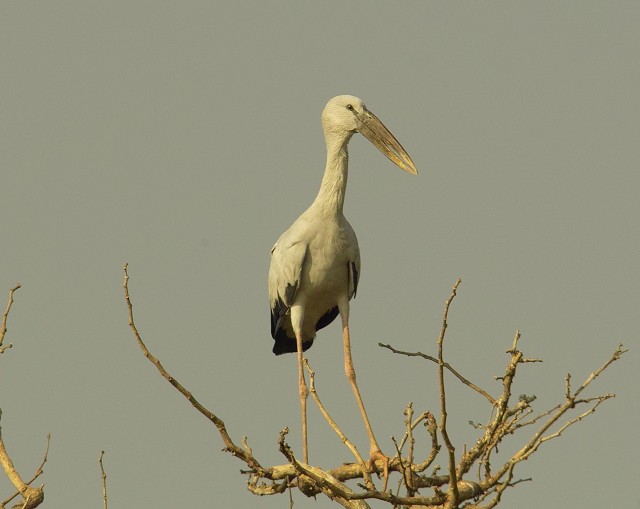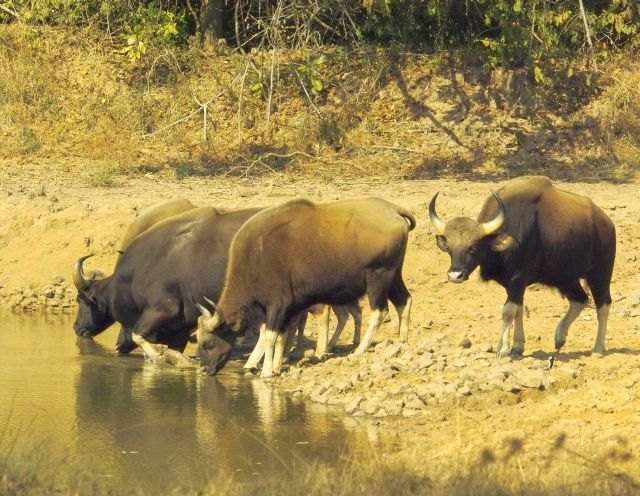Having only made my first visit to India in early 2010, I was very surprised to get an opportunity to go back to this amazing country just a few weeks ago. It was a chance remark to Sandra Stewart of Indian Wildlife Tours that opened the door. The outcome was that I led a trip to visit two National Parks and to watch two World Cup Cricket games. The latter included the really exciting tie between India and England.
The journey began with us flying to Delhi and immediately transferring to Nagpur by internal flight. Our next few days would find us three hours south, at the Serai Tiger Camp on the edge of the Tadoba National Park. This is a fairly new protected area and not that well known by Europeans. The camp itself was one of those curious, tented establishments with built-in bathroom etc. and very comfortable. The gardens of the camp were of interest, with lots of butterflies visiting the flowering plants. They turned out to have wonderful names such as Grey Pansy and a group known as Eggflies. Various small birds were here too, including Indian Silverbills and White-browed Wagtails.

Tadoba forest (photo: Derek Moore).

Daniad Eggfly (photo: Derek Moore).
As well as bordering a large extent of forest, there is also a dammed river nearby, giving extensive wetland habitats. Our first day was spent walking the long shoreline with its shallow margins and we were rewarded with many birds. Asian Openbills and Indian Black Ibis were very obvious, with many beginning the breeding process, displaying and carrying nesting material. Waders were too plentiful with Little Ringed Plovers and Wood Sandpipers being the most numerous but Ruff and a Temminck's Stint were also located. Wildfowl included Northern Shovelers, Northern Pintails and Garganeys but of more interest to Europeans were a few Comb Ducks, Spot-billed Ducks, a pair of Ruddy Shelducks and a single Cotton Teal amongst a group of Eurasian Coots. Both Bornze-winged and Pheasant-tailed Jacanas were plentiful and herons were represented by Great White, Cattle, Little and Intermediate Egrets. A few Grey Herons were also seen but Indian Pond Herons were the commonest of all.

Asian Openbill, India (Photo: Derek Moore)

Indian Pond Heron, India (Photo: Derek Moore)
The farmland between the water and the forest was also very productive. Early mornings saw hordes of Wild Boar around the muddy ponds and small numbers of Green Sandpipers too. Walking the dry, stony fields produced Paddyfield Pipits, Rufous-tailed and Short-toed Larks and a couple of superb Indian Coursers. If that was not enough, a ghostly male Pallid Harrier floated by and Black-shouldered Kites and Short-toed Eagles hunted overhead. Checking around the villages we found flocks of Ashy-crowned Finch-larks and Yellow-throated Sparrows. Scrubby areas provided great perching places too for Long-tailed and Bay-backed Shrikes.

Indian Courser, India (Photo: Derek Moore)

Bay-backed Shrike, India (Photo: Derek Moore)
Back at the camp as twilight beckoned Indian Nightjars put on a splendid show before a Collared Scops Owl kept up its monotonous calls until we fell asleep.
We enjoyed several sorties into the forest but found our guides were obsessed with finding Tigers, to the extent that we were often driving past good birds. We did manage to amend that behaviour a bit and soon caught up with Grey Junglefowl and Red Spurfowl. A favourite waterhole gave us wonderful views of Crested Serpent Eagles and later the splendid sight of a dozen Gaur coming to drink. These huge animals are the largest bovine in the world. Barking Deer (Indian Muntjac) were also regular visitors to the pool permanently patrolled by a pair of noisy Red-wattled Lapwings.

Crested Serpent-Eagle, India (Photo: Derek Moore)

Gaur at a drinking pool (photo: Derek Moore).

Red-wattled Lapwing, India (Photo: Derek Moore)
Patience at the pool also provided splendid views of a pair of Asian Paradise Flycatchers, a Tickell's Blue Flycatcher and a dazzling Black-faced Monarch. A fruiting tree elsewhere in the forest attracted hordes of birds with Black-naped Orioles and White-bellied Drongos being the most numerous. In an adjoining tree a Jungle Owlet was calling and a huge Brown Fish Owl blinked incessantly in the bright sunlight invading his daytime roost. Raptors seen around the forest included White-eyed Buzzard, Shikra and Oriental Honey Buzzard.
Inside the park is a large reservoir with very open areas. Spotted Deer, Sambar and Hanuman Langurs came to drink here and over 500 Lesser Whistling Ducks were generally present with small numbers of Little Cormorants. Indian Rollers and Little Green Bee-eaters were noted on most exposed perches and Plum-headed Parakeets screeched overhead. One new bird for everyone here was Sirkeer Malkoa, a large greyish cuckoo. White-rumped Munias and a Large Hawk-cuckoo were also observed.

Spotted Deer (photo: Derek Moore).

Hanuman Langur (photo: Derek Moore).

Little Cormorant, India (Photo: Derek Moore)

Indian Roller, India (Photo: Derek Moore)

Little Green Bee-eater, India (Photo: Derek Moore)

Plum-headed Parakeet, India (Photo: Derek Moore)
Tigers are successful in this park, with 23 cubs being born in 2010, but getting views was very frustrating. We missed a female with two cubs walking across the road by less than a minute but there was something of a bonus as we later had a Sloth Bear hurry in front of our Land Rover. Another great encounter was with Grey Mongoose — the Rikki Tikki Tavi of Kipling's books. We did see one Tiger asleep at about 200 metres. It eventually got up, urinated against a nearby tree and disappeared over a ridge. Later, as we left the Park at 5am on our journey back to Nagpur, a Tiger walked out in front of our bus and stood staring at us for some time. Good views were had by all.

Grey Mongoose (photo: Derek Moore).
At Nagpur we watched a very ordinary cricket match between New Zealand and Australia, which was not without bird interest: Dusky Crag Martins were nesting high up in the rafters of the stands and once a Black-shouldered Kite hovered over the pavilion.
We then flew to Bangalore for the England v India game. As in every Indian city, Black Kites were extremely numerous. As we had breakfast in a rooftop restaurant they flew level with us, peering in with a hungry look. In the hotel garden a couple of Red-whiskered Bulbuls kept us happy until we left for the match. As the floodlights were switched on late in the game Black Kites soared around the pitch, dropping down to the grass to take some insect or other. What opportunists: all this happened with a match in progress and the deafening noise of 70,000 fans accompanied by throbbing drums and loud music.
Our last destination was the Sunderbans, a vast mangrove swamp interspersed with rivers in the Bay of Bengal. After flying to Kolkata we took a three-hour bus journey followed by a two-hour boat trip before arriving at the Sunderbans Jungle Camp on Bali Island. What an idyllic spot. The camp is surrounded by a village and the camp is staffed by village people. On arrival we were treated to a costume drama explaining the spiritual relationship between village folk and the tiger goddess Borobini. Over 100 people a year are killed by Tigers in the area and it is believed that the goddess protects people from attack when fishing and gathering honey.

River life in the Sunderbans (photo: Derek Moore).

Bali village (photo: Derek Moore).
We explored the area by boat, and quietly cruising the creeks we saw many kingfisher species. The huge Brown-winged Kingfisher was very obvious, but we also found Black-capped, Collared, Pied, White-throated and Common. We had struggled to get good views of Red Junglefowl on a previous visit to India but here they were much more obvious, particularly at waterholes. There is something quite surreal about seeing a chicken take off and fly pheasant-like across a wide river.

Brown-winged Kingfisher, India (Photo: Derek Moore)

Black-capped Kingfisher, India (Photo: Derek Moore)

Collared Kingfisher, India (Photo: Derek Moore)
The only places we could land were fenced-off compounds with watchtowers, usually sited by a large created waterhole. Here animals, mainly Spotted Deer, would come as well as numerous bird species. Water Monitor Lizards were obvious by larger pools and River Terrapins surfaced occasionally. Large groups of Jungle Mynas, Red-vented and Red-whiskered Bulbuls and even a Changeable Hawk-eagle would come to drink. Brahminy Kites patrolled overhead and Lesser Adjutants also came to take advantage of the fresh water. Smaller birds surrounded the area and we found Dusky, Greenish and Yellow-browed Warblers as well as Red-breasted Flycatcher and Brown Shrike. Common Iora and Oriental White-eyes were numerous, and a splendid Scarlet-backed Flowerpecker was also seen briefly. Sadly no Tigers came to the waterholes, but we did see a lot of recent tracks.

Sunderbans waterhole (photo: Derek Moore).

Jungle Myna, India (Photo: Derek Moore)

Brown Shrike, India (Photo: Derek Moore)
Out on the water there were many muddy areas exposed at low tides and large flocks of waders gathered. Larger species were Whimbrel or Curlews, but the most numerous were Common Sandpipers. Checking closer revealed Redshank, Greenshank and a few Dunlin. Larger flocks of Pacific Golden Plovers were also noted with a few Greater Sand Plovers. The most interesting for us though was the very numerous groups of Terek Sandpipers — a species seldom seen in Europe. Ospreys also hunted the open water and were met with on most days. On occasions we were also able to see enormous Estuarine Crocodiles pulled out onto mud banks, a reminder of how dangerous fishing by standing in the water can be.

Terek Sandpiper, India (Photo: Derek Moore)

Estuarine Crocodile (photo: Derek Moore).
Around the large numbers of fishing boats both Pallas's and Brown-headed Gulls were encountered and also good numbers of Whiskered Terns. We found a large raft of ducks in one particular area, of which the majority were Wigeon, Gadwall, Northern Pintail and Northern Shoveler. A single Garganey came to light later when checking photographs. Heading back on one late evening, we were delighted to come across a couple of the scarce Irrawaddy Dolphins.

Pallas's Gull, India (Photo: Derek Moore)

Whiskered Tern, India (Photo: Derek Moore)
Walking around the village also produced many birds. Purple and Purple-rumped Sunbirds were numerous, as were Common Mynas and Asian Pied Starlings. Spotted Doves were also a common bird in the camp. Searching the mangrove fringes produced Blyth's Reed Warblers and more Greenish Warblers. Streak-throated Woodpeckers and Black-rumped Flamebacks were also regularly seen, and on one occasion a handsome Black Bittern fed briefly at a nearby pond. Citrine Wagtail, Asian Brown Flycatcher, Small Minivet, Black-hooded Oriole, Asian Koel and Large Cuckoo-shrike were also noted near the village.

Female Purple Sunbird, India (Photo: Derek Moore)

Asian Pied Starling, India (Photo: Derek Moore)

Black-rumped Flameback, India (Photo: Derek Moore)
All too soon our time had sadly come to an end and we were packing up for the long journey back to the UK from Kolkata. It was another great experience in this large and diverse country. Having had a taste for two consecutive years, I am beginning to get hooked.

